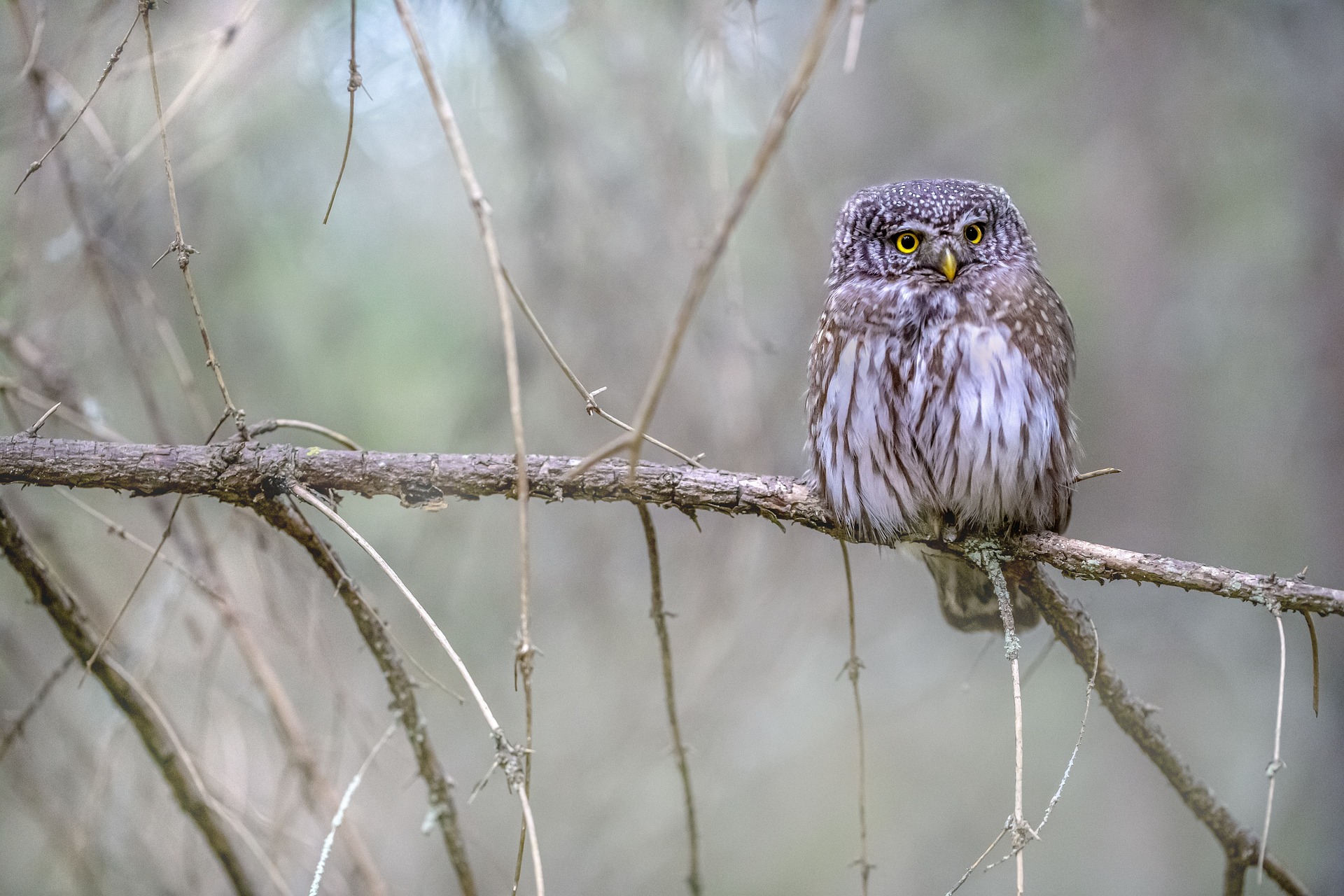The Eurasian Pygmy Owl (Glaucidium passerinum) is the smallest owl species in Europe, standing out for its diminutive size and feisty nature. Despite its small stature, this owl is a skilled and determined hunter, often preying on animals nearly its own size. It inhabits coniferous and mixed forests across Europe and parts of Asia, making its home in tree cavities and remaining largely elusive due to its shy and secretive behavior.
Physical Description:
- Size: The Eurasian Pygmy Owl is tiny, measuring only about 15–19 cm in length with a wingspan of 32–39 cm, and weighing around 50–70 grams.
- Plumage: Its plumage is generally brownish-grey with white spots on the crown and nape. The underparts are pale with dark streaks, while the upperparts are a more uniform brown. This coloration helps it blend in with its woodland surroundings.
- Eyes and Beak: Like most owls, it has large, forward-facing yellow eyes that give it excellent binocular vision. Its beak is small and pale yellow, but sharp, suited for catching prey.
- Tail: The owl has a short, barred tail that often flicks up and down, a typical behavior displayed while hunting or perching.
Behavior:
- Hunting: Despite its size, the Eurasian Pygmy Owl is an accomplished predator. It hunts primarily at dawn and dusk (crepuscular), although it can be active during the day as well. Its diet consists mostly of small birds, voles, mice, and shrews, but it can occasionally take larger prey, including birds that are almost as big as itself. It typically captures birds in flight or pounces on small mammals from a perch.
- Stashing Prey: This owl is known for caching surplus food, especially during colder months when food is scarce. It stores prey in tree cavities, crevices, or even under snow.
- Call: The Eurasian Pygmy Owl’s call is a soft, repetitive whistle that is often heard during the early spring mating season. Males use this call to establish territory and attract mates.
Habitat:
The Eurasian Pygmy Owl prefers coniferous and mixed forests, particularly in mountainous regions or old-growth forests with plenty of cavities for nesting. It can also be found in taiga regions, though it generally avoids open landscapes. It favors areas with an abundance of small mammals and birds, which serve as its primary prey.
Breeding:
- Nesting: The Eurasian Pygmy Owl typically nests in natural tree cavities or old woodpecker holes. They do not build their own nests, so the availability of suitable nesting sites is crucial to their habitat choice.
- Eggs: The female lays between 3 and 7 white eggs, which she incubates for about 28–29 days. During this time, the male provides food for the female.
- Chicks: Once hatched, the chicks remain in the nest for about 4 weeks, and they become independent after leaving the nest. However, they often stay near the parents for some time while they learn to hunt.
Distribution:
The Eurasian Pygmy Owl is found across a wide range, from western and central Europe through northern Scandinavia and into the forests of Siberia and parts of Central Asia. Its range overlaps with various other owl species, although its size and behavior allow it to occupy a unique ecological niche.
Conservation Status:
The Eurasian Pygmy Owl is listed as Least Concern by the IUCN due to its relatively wide distribution and stable population. However, it is somewhat vulnerable to habitat loss, particularly the destruction of old-growth forests that provide essential nesting sites. In some regions, deforestation and logging activities have negatively impacted local populations.
Interesting Facts:
- Diurnal Activity: Unlike many other owl species, the Eurasian Pygmy Owl is more active during the day, often seen hunting in the early morning or late afternoon.
- Aggressive for Its Size: Despite being the smallest owl in Europe, the Eurasian Pygmy Owl is surprisingly aggressive. It will fiercely defend its territory and even attack larger birds that come too close to its nest.
- Prey-to-Body Size Ratio: This tiny owl is capable of catching prey almost as large as itself, particularly small birds such as sparrows, tits, and finches, which it typically kills with a swift bite to the neck.
Ecological Role:
The Eurasian Pygmy Owl plays a crucial role in controlling populations of small birds and rodents in its forest habitats. By preying on these animals, it helps maintain the ecological balance. Additionally, its reliance on natural tree cavities highlights the importance of old-growth forests, which also support many other species of birds, mammals, and insects.
Conclusion:
The Eurasian Pygmy Owl (Glaucidium passerinum) is a fascinating and resourceful bird that defies its small size with its powerful hunting skills and bold behavior. Its preference for dense forests and secretive habits make it difficult to spot, but its distinctive call and tenacious nature make it a beloved species among birdwatchers and researchers. While its population remains stable, conservation efforts to protect old-growth forests are essential to ensuring that this tiny owl continues to thrive across its broad range.
Views: 1450
Subscribe to the newsletter:
